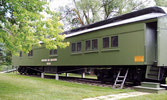A very special story
School on Wheels Museum tells of dedication of Sloman family
There are children who move around a lot in their childhood because of their parents work but few can match Toby Sloman Rainey and her family. Not only did the Sloman children split their year between summer vacations in Clinton and school years in Northern Ontario, but they relocated each week as the school car they lived in was dropped off at a different isolated siding along the rail line to educate children from another wilderness community.
Visitors to the museum (it’s open 11 a.m. to 4 p.m. Thursdays to Sundays plus holidays beginning May 16) can glimpse how the Sloman family lived in one end of the converted railway car while the other end provided room for Fred Sloman to teach the children of northern families who wouldn’t have received an education otherwise.
Built in 1914, the railcar is one of two cars which were used for the travelling school. It was also one of the last wooden passenger cars built by the Crossen Car Manufacturing Company in Cobourg, as wood went out of style, replaced by steel. The car was originally intended to transport European colonists to Western Canada, and was even used as a hospital car for the first few months after it was built.
This is actually the second of the school cars used by Fred Sloman and his wife, Cela, both of whom grew up in Clinton. The first car they used was a coach car, which functioned as the school for 14 years but by 1940 the original school car was too crowded for both the students and the Sloman family, which now included five children. The car now on display in Clinton was refitted for their use.
The railway school cars were part of an experiment between the Ontario Department of Education and the Canadian National and Canadian Pacific Railroads. In the case of the Slomans’ school car, each week, a CN Rail “wayfreight” train moved the school car to specially-built sidings between Capreol and Folyet, where it would remain for five days or so. Pupils would then be left with enough homework to last until their school returned to them from a full tour of its 149-mile (240 km) schoolyard. More than 1,000 children graduated from this unique school, including Fred and Cela Sloman's own five children.
Fred Sloman was inspired to teach in the North after an encounter with a wounded northern Ontario soldier at a British hospital during WWI. The soldier was unable to write letters home, because he had never been to school, and therefore never learned how to write.
Teaching in a regular school, however, wasn’t the answer that Fred was looking for. There were other children out there he felt needed this education more, and by taking the job on the school car, he found a way to bring it to them.
The Slomans taught a wide range of subjects, including everyday life skills such as how to order from a catalogue and the basics of agriculture, starting with where their food came from. Cela devoted much time to passing on her knowledge and experience to the women by teaching dressmaking skills, how to garden in Northern Ontario, and a lot about child care.
This was not the kind of school where just anyone could teach. The fact that it was a mobile school created a number of challenges in and of itself, but for the actual teaching, they were dealing with children of all different ages who, more often than not, had never attended a day of school in their life.
The Slomans continued to teach until they retired in 1965, two years before the end of the school car program in 1967. Fred passed away in 1973 at the age of 78, having spent only two years in retirement before suffering a stroke, after which he spent his remaining years in a hospital bed.
His unbridled passion for teaching and his dedication to ensuring that no child was ever left behind so long as he could reach them, earned him recognition in the Heroes of the Canadian Railway Hall of Fame in 2003.
Cela Sloman was named a Member of the Order of Canada in 1984.
After the cancelation of the program, the railcar then seemed to vanish from the face of the earth. It wasn’t until 1982 that the car was found by William Stephenson, a long-time friend of the Slomans, who immediately recognized the car number from a list of railcars for sale in a Canadian National rail yard in Toronto.
When Cela Sloman and her daughter, Margaret, received word that the car had been found, they didn’t hesitate to go and see it with their own eyes.
They put in a request that the car be bought by the Town of Clinton, where Margaret continues to live until this day, and their request was approved. It required some repairs before it could be physically moved from Toronto, but it eventually found its way to Clinton, at which time volunteers from the community set to work restoring the car.
Finally able to rest its weary axles after so many years of travelling the tracks, the school continues to educate children and adults alike as people travel from all over to see the railcar and uncover the history of one of humankind’s more scenic modes of transportation.


